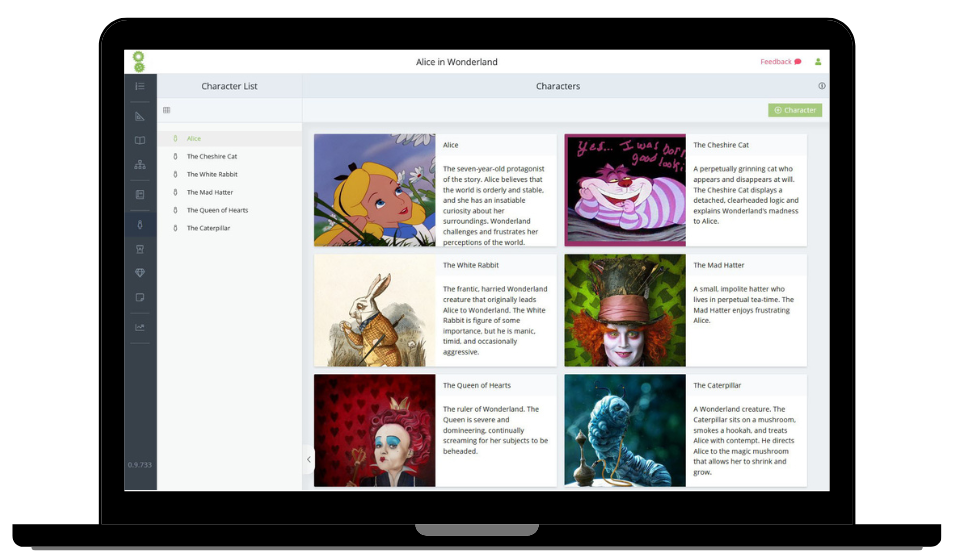
The Snowflake Method: From Idea to Novel in 10 Steps
If you’re a new writer, you know it can be frustrating to have lots of ideas and no clue how to turn those ideas into a book.
If you’re more experienced, you know it can take some time and experimentation to find the approach that works best for you.
There are many popular and proven methods for getting those ideas out of your head and onto paper (with the least stress possible).
One of the most popular and well-known is the Snowflake Method.
It’s so successful because it breaks the novel writing process down into manageable, logical, bitesize tasks – each building on the previous.
In this post, we’ll explain the background of the Snowflake Method and go through each of the steps in detail.
Is the Snowflake Method an Outline?
Sometimes the Snowflake Method is referred to as an Outline, but that’s misleading.
An outline is a framework for the structure of a story.
The simplest sort of novel outline is: Beginning, Middle, End.
Then you have much more detailed outlines, such as the Hero’s Journey or Save the Cat.
They give you some guidance about what sort of events should happen in your first chapter, what needs to happen in the first third of the novel, what events work at the midpoint, and how to create an effective finale and ending.
A method, on the other hand, is a plan for how to actually get from a blank page to a completed manuscript.
The Snowflake Method is one type of planning or plotting method, but there are many others, including the Novel Factory Roadmap.
The Snowflake Method is a ‘Planning’ type of method. This means that through the steps, you work out a lot of the details of your plot and characters before you start writing.
This is in contrast to a ‘Pantser’ type method, where you just sit down with only a very rough idea of the story in your head and start writing from the first sentence of the novel, and keep going in a linear fashion until you write ‘the end’.
Most authors fall on a spectrum somewhere between pantsing and plotting, with the balance often changing as they gain more experience.
What is the Snowflake Method?
In a nutshell, the Snowflake Method is a way of writing a novel where you start with a single sentence summary of your novel and expand on it in ever more complex levels.
It was designed by a scientist named Randy Ingermanson.
Randy came up with the Snowflake method initially as his own personal method of writing a book.
In fact, he didn’t really think of it as a method at all, at the time. He thought it was just the most obvious and logical way to ‘design a novel’, and that probably everyone else automatically did the same thing.
But after he had sold a few novels and started getting asked to speak at writing conferences, he realised that he had hit on something more special than he realised.
Since then, while his own novels have had some measure of success, what has really made him famous is The Snowflake Method.
His article explaining it in overview has been viewed more than six million times.
So you may wonder, why is this method named after a snowflake?
It’s because when you use it, your story will grow the same way a snowflake does, fractally, starting from a single point and blooming outward in a series of steps. This short video demonstrates how it works.
The Snowflake Method begins with a single point — your idea. It then lets your story grow from there, in a series of organic steps, ensuring you’re covering all your bases (character, plot, world, etc.) and making sure you have all the elements of a good story.
How to Write a Novel Using the Snowflake Method

But enough background — let’s get into the nitty gritty.
Here are the steps of the Snowflake Method, including instructions, time estimate and desired result.
Step 1: Create a one-sentence summary of your novel.
In about 15 words or less, create your elevator pitch, or a summary of your main story.
It should include the main character and the key thing they do in the story. This is usually an objective or a challenge.
This sentence will sound a lot like the sentence they’ll put on your book when you get on the NYT Bestseller list (so you can find more inspiration and examples there)
For example:
- Wonder: A boy with a facial deformity starts school.
- Circe: Zeus banishes Helios’s daughter to an island, where she must choose between living with gods or mortals.
- One of us is Lying: For five students, a detour into detention ends in murder.
Notice that no character names are used at this point, stick to key descriptors of your main character or characters.
Good one-sentence summaries should ideally introduce some empathy for the main character, stakes and conflict.
Taking the first example, if it had simply been ‘a boy starts school’, then we’re not exactly leaping out of our seats with excitement.
But the fact that he has a facial deformity neatly does two things. It gives us empathy for him, and it gets us worried about how he’s going to be treated when he arrives for his first day.
In the second example, empathy and conflict are built by telling us Helios’s daughter is banished, and further conflict is raised by expressing that she must choose between gods and mortals.
Finally, the third example contains murder as the conflict, and we immediately have empathy for the students – young people who have been suddenly thrust into a horrifying situation.
Remember that writing a great single sentence summary is probably harder than writing a novel, so don’t beat yourself up if you’re struggling with it. Just keep practising, and you will get better with time and experience.
Time required: 1 hour
End result: A one-sentence summary of your main story.
Step 2: Create a single-paragraph summary of your novel.
Next, expand your single sentence summary into one paragraph, about five sentences long, that describes your story’s set up, major turning points, and ending.
Randy likes to think of it as ‘three disasters plus an ending’, with each disaster taking up a quarter of the book, and the disaster taking up the last quarter.
However, you could use a different type of plot outline to create your paragraph outline.
Time required: 1 hour
End result: A one-paragraph summary of your novel.
Step 3: Breathe life into your characters.
So, we’ve got a high level overview of our plot. Now let’s do the same for our characters.
Write a one-page summary for each of your main characters. Great fiction is driven by great characters, so spending time developing them is a great investment.
In each summary, include:
- Your character’s name
- The character’s motivation (what do they need?)
- Your character’s goal (what do they want?)
- The character’s conflict (what is their main flaw or obstacle)
- The character’s epiphany (what will this character learn throughout the course of the story?)
- A one-sentence summary of the character’s storyline
- A one-paragraph summary of the character’s storyline
Time required: 2 hours per character.
End result: A one page character overview for each main character.
Step 4: Flesh out your story.
Now, begin to expand on each sentence of the story summary you created in Step 2.
Develop each sentence into a paragraph of its own. Randy recommends having each of these paragraphs ending at a turning point or in disaster except the last one, which will end your book.
When you’re done you should have roughly a one page outline of your book. Don’t worry if it doesn’t exactly fit on one page.
Length isn’t as important as seeing whether your story is working or not. If something isn’t quite right, it’s better to know now than after you’ve invested many hours (or even weeks) into writing.
Time required: 1 to 2 days.
End result: A one-page skeleton summary of your novel.
Important note: Never be afraid to revisit and revise earlier steps as you learn more about the story. It’s perfectly natural and a good thing that your story evolves and you make tweaks as you learn more.
Step 5: Expand on your characters.
In step five we return to our characters.
Write a one page description of the story from the point of view of each of the major characters, and a half page one for each of the minor characters.
This can be really fascinating and really lift your novel into three dimensions, as each of your characters has their own experience of the events. It can highlight potential plot holes, inspire interesting new twists and open up new avenues for conflict and relationships.
Note that you don’t need to do this step for every single character – minor walk on roles don’t require it.
Time required: 1 to 7 days.
End result: A single page description of the story for each major character, and a half page for each supporting character.
Step 6: Write a four-page synopsis of your story.
You might be starting to notice a pattern here — one that represents the fractals of that snowflake.
The single sentence that you turned into a single paragraph that you turned into a single page…
Now you turn that into four pages.
In my experience, I get quite involved in this step and go way further than four pages, sometimes writing up to ten.
But again, the exact number of pages isn’t important – what’s important is that you’re layering creativity into your story.
At this point the work you’ve done on your characters in the previous step will likely influence your plot, and you’ll weave some new details in.
You’ll also have to think harder about how things tie together and where important plot developments and twists will be.
As you write this longer summary, you’ll want to return to your earlier steps and update them with this new knowledge.
Time required: Up to a week.
End result: A four-page synopsis of your story.
Step 7: Create character charts.
Effective authors often know far more about their characters than they ever reveal on the page.
This intimate knowledge helps their characters feel more like real people with backstory, quirks and internal contradictions.
Build on the information you created in Steps 3 and 5, but this time, add more detail (like physical descriptions, quirks, birthdays, etc.) and think hard about your characters’ arcs. How will they change throughout the story? What will they learn?
It’s the emotional journey your character goes on that will stay with readers long after they’ve forgotten the nuts and bolts of the plot.
Time required: A week to a month.
End result: Full-fledged character charts for each of your important characters.
Step 8: Create a list of your scenes.
This step will ease you into writing your complete first draft.
Take the four-page synopsis you created in Step 6 and use it to make a list of all the scenes you’ll need for your novel.
You can do this with a spreadsheet or with dedicated novel writing software.
For each scene, note down the Point of View character, and a brief summary of what happens in the scene. No more detailed than what you could fit on an index card or post it note.
Time required: Two to four weeks
End result: A completed list of scenes with brief descriptions.
Step 9: Write a narrative description of each of your scenes.
This step further eases the pain of the first draft, as you’ll already have done so much of the work.
For each of your scene descriptions, write a narrative description of what happens in that scene. This simply means write a more detailed description of everything that happens in that scene, in order.
Sketch out the conflict and note down any specifically cool description or dialogue that hits you.
Randy calls this the ‘prototype first draft’ which is a great way to put it. It’s not quite the first draft, because it’s not written in prose. But it’s got all the major beats, in the right order.
Once this is done, you might want to print it out, and then you can note any new ideas you have in the margins.
Time required: About a month
End result: A “prototype” first draft that has done all the legwork of the first draft
Step 10: Write your first draft.
You’ve done a lot of prep work up to this point, and here’s where you’ll see it all pay off. You’ll be amazed at how quickly you’ll be able to write your first draft, and with a much higher quality, if you’ve done all the steps up until now.
When you know exactly where the story is going, it’s easy to write several thousand words per day. This means it’s possible to get a first draft of 50,000 words completed in one month.
You know your characters, you know your story, you’ve made revisions and filled in the gaps where necessary. Your story will fly from your fingers!
And the best part is that because you know you’ve got the high level structural stuff solid, you can focus all your creative juices on the minutiae of choosing the most perfect words and sentences and creating atmosphere, drama and tension as appropriate.
Time required: One month
End result: Your finished first draft. Celebrate!
What Are the Benefits of Using the Snowflake Method?
There are some excellent reasons why the Snowflake Method is so popular.
1. It gives new writers with lots of ideas a place to start.
One of the problems new writers often have is that they are bursting with ideas, but have no idea how to organise them into a coherent novel. The Snowflake Method offers a logical method for taking all those ideas, wrangling them into a smooth flowing order.
3. It makes the entire novel writing process more manageable.
The idea of writing a whole novel is so daunting people sometimes become paralyzed by the pressure and never even start.
This method breaks it down into manageable steps. It balances focus on plot and character, so you don’t fall down the trap of having one and not the other.
Side note: most of these same benefits also apply to the Novel Factory Novel Writing Roadmap, since the Roadmap uses the same ‘build outwards’ principle as the Snowflake Method foundation.
4. It makes finishing your novel faster and easier.
Having a repeatable method saves time because you don’t waste hours scratching your head wondering what to work on next. You also don’t spend time working on things you don’t need.
And the way it builds from the centre of the story outwards, rather than from the beginning of the story to the end, means you are less likely to create contradictions and random plot holes that need to be filled in later.
Ready to Use the Snowflake Method to Write Your Novel?

There are many methods you can use to get a story out of your head and into a well-written, finished first draft.
If you’ve been struggling, or if you’re currently writing your first novel, why not give the Snowflake Method a try?
It’s easy to follow, easy to understand, and you don’t need to study writing craft for years before you can put pen to paper.
For a more detailed explanation of each step, you might check out the Novel Factory Roadmap. It works on a similar principle to the Snowflake Method, but also includes steps for how to structure goals and conflict, and covers redrafting and editing, too.
So check out the roadmap today, and see how quickly and easily you can finish your novel.
Unlock your writing potential
If you liked this article by the Novel Factory, then why not try the Novel Factory app for writers?
It includes:
- Plot Templates
- Character Questionnaires
- Writing Guides
- Drag & Drop Plotting Tools
- World Building resources
- Much, much more

